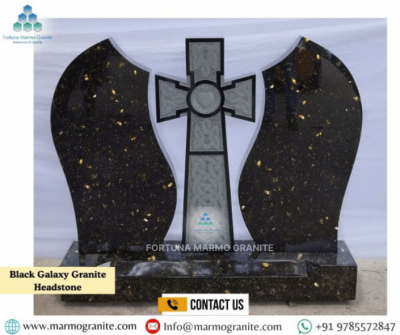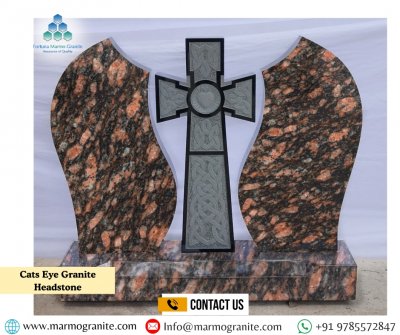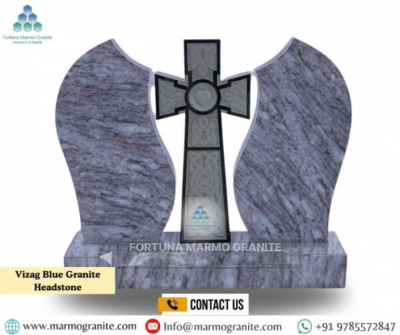Celtic Cross Memorials – A Symbol of Faith & Remembrance in Ireland
Celtic cross memorials are iconic symbols of faith, heritage, and remembrance in Ireland and across the world. These timeless structures, blending Christian iconography with ancient Celtic traditions, have stood the test of time, offering solace and tribute to the departed. With their distinctive design, deep historical significance, and enduring presence, Celtic cross memorials are not only a tribute to the deceased but also serve as reminders of Ireland's rich cultural and spiritual history.
Vizag Blue Granite Headstone
The Vizag Blue Granite headstone is a striking and elegant memorial choice, characterized by its deep blue-grey hue and subtle undertones of black, making it a distinctive and timeless tribute. This granite's fine grain and polished surface reflect light beautifully, creating a serene and dignified presence. The rich color, combined with the stone's natural strength and durability, ensures that the headstone will remain a lasting and resilient marker for generations to come. Ideal for those seeking a headstone that stands out while maintaining a sense of understated elegance, Vizag Blue Granite offers a sophisticated balance of beauty and resilience.
The Origins of the Celtic Cross
The Celtic cross as we know it today is a fascinating fusion of pre-Christian and Christian symbols, a marriage of two traditions that have shaped Ireland's identity. The cross's most striking feature is the inclusion of a circle at the intersection of the arms, which represents the union of the earthly and the divine. The circle itself, often referred to as a "halo" or "wheel," symbolizes eternity, wholeness, and the infinite nature of God. In Celtic tradition, the circle also represents the sun, a key element of the pagan religion.
The Celtic cross originated in the 5th century, when Saint Patrick, the patron saint of Ireland, introduced Christianity to the Irish. According to legend, he first used a simple cross to represent the Christian faith. He then added a circle atop the cross to symbolize the sun, an important emblem in Celtic paganism. This combination of Christian and pagan elements helped the cross resonate with the local population. It also played a key role in spreading Christianity throughout Ireland.
The Symbolism of the Celtic Cross
The Celtic cross holds profound symbolic meaning, both spiritually and culturally. The vertical beam of the cross represents the divine, the eternal, and the connection between heaven and earth, while the horizontal beam symbolizes the human experience and the connection between people. The circle, which envelops the intersection of the cross, symbolizes eternity, wholeness, and the infinite nature of God's love.
The interlacing patterns that are often carved into Celtic crosses represent the interconnectedness of all life, a theme prevalent in Celtic spirituality. These patterns, which can include knots, spirals, and other geometric shapes, are symbolic of the continuity of life and the cyclical nature of existence. In this sense, the Celtic cross memorial serves as a reminder of the eternal nature of the soul and the continuity of life beyond death.
The Role of the Celtic Cross in Irish Heritage
Beyond its Christian connotations, the Celtic cross is also deeply intertwined with Ireland's cultural and national identity. The rich heritage of Ireland, including its language, music, and traditions, is closely tied to the symbolism of the Celtic cross. In Ireland, the cross is not just a religious symbol but a cultural artifact that represents the resilience and strength of the Irish people.
The importance of the Celtic cross in Irish history can be seen in its prevalence in Irish graveyards and churches, where it serves as both a spiritual symbol and a marker of Irish identity. Over the centuries, the cross has evolved to become a universal symbol of Irish pride, commemorating not only the deceased but also the enduring legacy of Ireland's history and traditions.
Celtic Cross Memorials in Irish Cemeteries
Celtic cross memorials are a prominent feature of Irish cemeteries, where they have been used for centuries to mark the graves of the departed. These memorials are often intricately carved from stone, with detailed depictions of Celtic knots, spirals, and other traditional symbols. The craftsmanship of these memorials is a testament to the skill of Irish stonemasons, who have passed down their craft from generation to generation.
In many Irish graveyards, Celtic cross memorials are placed as a tribute to the deceased, with the cross standing as a symbol of faith, love, and remembrance. These memorials often serve as focal points in the graveyard, offering a place for family members and loved ones to reflect, mourn, and honor the memory of the deceased.
The Popularity of Celtic Cross Memorials
In recent years, Celtic cross memorials have gained popularity beyond Ireland, with people of Irish descent or those with an appreciation for Celtic heritage seeking to commemorate their loved ones with this distinctive symbol. Whether it is an Irish-American family wishing to honor their roots or someone with a deep spiritual connection to the Celtic tradition, the Celtic cross serves as a meaningful and powerful symbol.
The design of Celtic cross memorials can vary widely, with some featuring simple, unadorned crosses while others incorporate elaborate carvings and detailed depictions of religious and Celtic symbols. This flexibility in design allows for personalization, making the Celtic cross a fitting memorial for people of diverse backgrounds and beliefs.
Celtic Cross Memorials and the Landscape of Ireland
Celtic cross memorials enhance the Irish landscape with historical and spiritual significance. You can find them in rural areas among rolling hills and in urban settings, often marking ancient burial sites or acting as landmarks. Ireland's natural beauty combined with the presence of these crosses creates a deep connection to both past and present.
Moreover, Sweeping hills, dramatic coastlines, and lush valleys provide a breathtaking backdrop for the monuments. Placed in a quiet corner of a graveyard or standing tall in an open field, Celtic crosses appear woven into the very fabric of the landscape.
One of the most iconic sites for Celtic cross memorials is the Clonmacnoise Monastery in County Offaly. This ancient site is home to a collection of high crosses, many of which date back to the 9th and 10th centuries. Additionally, These crosses, towering over the surrounding landscape, are a testament to the skill of early Irish artisans and the enduring spiritual significance of the Celtic cross.
Similarly, the historic graveyard at Kilfenora in County Clare is home to a number of well-preserved Celtic crosses, which attract visitors from around the world who are eager to witness these remarkable pieces of Irish heritage.
Conclusion
Celtic cross memorials symbolize faith, remembrance, and cultural heritage. In addition, They reflect the deep spiritual connection between the past and the present. These iconic crosses blend Christian traditions with ancient Celtic beliefs, representing both eternal life and the interconnectedness of existence. You can find them in Irish graveyards, on memorials, or marking significant historical sites. The Celtic cross continues to resonate with people of Irish descent and anyone who values its profound symbolism.




